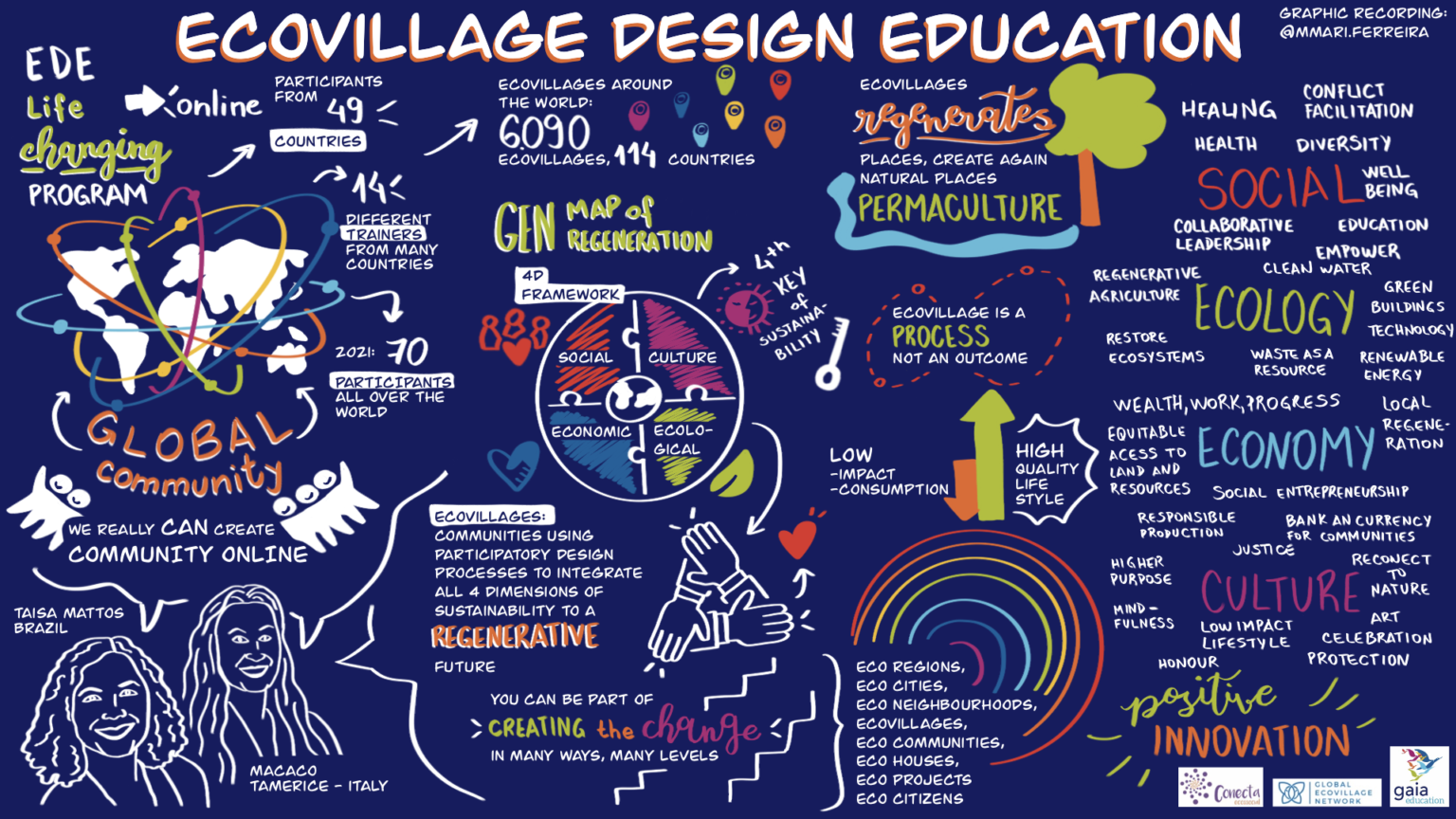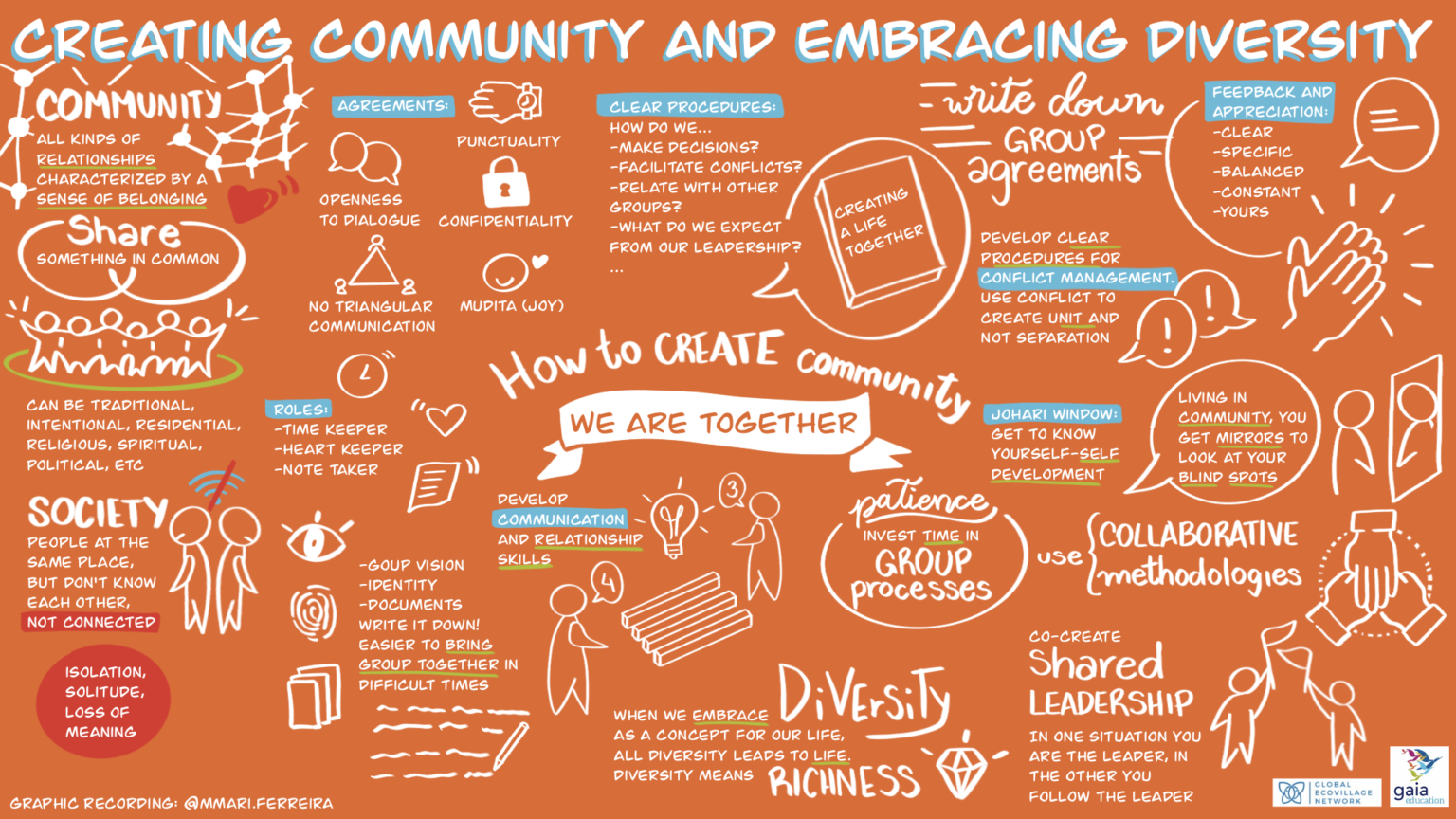Are you looking for a participatory learning experience about how to create a new way of living with low environmental impact and high quality of life, bringing together the four areas of regeneration: social, ecological, economic, and culture/worldview? Then this might just be for you.
Originally combined into a one-month experience in an ecovillage, The Ecovillage Design Education programme (EDE) is a training created by Gaia Education and the Global Ecovillage Network and certified as a Key Partner of UNESCO Global Action Programme on Education for Sustainable Development.
Macaco Tamerice and Taisa Mattos, sociologists and ecovillage educators, have now adapted it during the pandemic into a Live Online format. This year, 50 participants from all over the world are meeting weekly online and getting trained by all pioneers of the ecovillage movement. Here are some of the learnings and explanation to what an ecovillage is all about.
« In society people have lost touch with their individual potential in name of society’s needs. Separating more and more, because they weakened their own being. How to build a community with empowered individuals? » – Suelen, participant of the EDE

What is an ecovillage?
Currently, more than half the world’s population live in towns and cities, often without having ever considered their impact on the environment around them. It’s only recently that politicians have started becoming aware of the importance of living in accordance with nature, and using streams, rivers, and trees for our overall health and well-being and notably in combatting urban pollution.
Since the 1990s, the term “ecovillage” has been used more and more to refer to communities that left or have never been part of the consumer society and intend to live more simply, closer to nature. It is more than 10,000 regenerative hotspots now revealed all over the world that are implementing the social and ecological transition the world needs with commitments to minimize their carbon footprint impacts.
“If only 5% of European populations were engaging in climate change mitigation projects as communities, carbon savings would be sufficient to achieve 85% of the 2020 carbon emissions reduction targets” – TESS European survey (2016)
In Europe, very little or no natural space has been preserved so in the ecovillages, the ecological dimension is crucial to regenerate the landscape: it includes for example natural housing, local food and green energy consumption. Ecovillages are laboratories, which explore solutions and innovate to tackle current environmental challenges such as climate change.

In modernity, there is a disruption of the principles of community. We have become disconnected from the spirit of community. But there are tools to reconnect.
The Ecovillage Design Education 2022 edition started with the Social dimension of regeneration. John Croft from Australia shared why it is time to widely use Dragon Dreaming, a project management method.
Temperature anomalies are causing ice to thin, increasing the rate of melt and accelerating sea-level rise. Exposure to more water causes greater absorption of sunlight, accelerating heating of the world’s temperatures. Higher temperatures increase the severity of floods, fires and droughts, ocean acidification and destruction of coral reefs. We need to begin cutting greenhouse gas emissions urgently if we are to avoid a runaway climate catastrophe by 2050.
Although we have known about greenhouse gas warming for over 150 years, current projections are all inadequate. We are caught in a situation of too little too late. If all countries achieve their current targets/pledges set within the Paris climate agreement, the average estimated warming by 2100 will be 2.5 to 2.8°C. This will go well beyond the overall target of the Paris agreement to keep warming “well below 1.5°C”. So far, no country’s commitments meet the +1.5°C target. As a result, we risk huge climate tipping points, where positive feedback loops make matters worse, with planet-wide extinctions and uninhabitable zones likely.
It is time to learn how to work together to collaborate in order to maintain our species on Earth. Every project starts with an individual and his environment, integrating theory (thinking) and practice (feeling and sensing). Every project starts with the dream of one person. 90% of the projects we observe get stuck in the dreaming stage, in order to make your dreams come true, you need to share your dreams. Sharing your dreams it’s an intelligent process that connects you to the world. In Indigenous cultures, dragons often symbolise what we are most afraid of and when we learn to dance with our dragons we liberate our power sleeping inside of us.

Why its time for dragon dreaming
Dragon dreaming is a way of making our dreams come true. Every dragon dreaming project needs to achieve a win-win-win. It has to be: A win for me – a project of personal growth for the people involved, that participants doing a project are committed to their own healing and empowerment. A win for the community – projects of community building, which strengthen the adaptive capacity and resilience of the communities of which they are part of. A win for the earth – projects that work in service to the Earth, for the well-being, regeneration, and flourishing of life itself.
“We need to know what kind of people we are and which are our partners. In some environments we can be more introverted or more extroverted, we need to know the edge of our comfort zone. The dragon is outside it. The dreamers work with intuition, the doers with the senses, the planers think in advance and the celebrators use reflection. Build a team to support your project with doers, dreamers, planners and celebrators, all parts should be equal. Each needs to have the same number of tasks. This is easily doable with 3 questions: Which particular task would you be very enthusiastic to do? Which of these tasks scares you? Which of these tasks you could do but not necessarily want to do? Set up a project with a board game, it must be fun!” – John Croft, EDE guest and trainer
Building projects in the community is not an easy task. With 2 people working together, there are 3 different relationships (the relationship between each other and the relationship each one has with themself). 4 people involve 15 relationships. 5 people involve 31 relationships. It escalates quickly. You need to identify your active supporters, your passive supporters, the bad supporters (negative) and the active resistors. The active resistors are the ones who will actually make your project the best. Ask them why do you think is bad, wrong or nonsense. Creating a dream circle will help shift mindsets and harmonise a team.

Key learnings and highlights
We are both individuals and social animals. We are wired to be a community. The individualistic world approach doesn’t allow us to see humans as connected, part of something bigger.
“Community start with yourself, your family, nature, the other beings, with life. It can be rural, urban, online, traditional, intentional, residential, religious, spiritual or even political.” – Taisa Mattos, EDE trainer
The community concept is based on the fact that each person is invaluable and truly irreplaceable. Each person has a gift to give, a contribution to make to the whole. The kind of gift a person brings, the kind of being a person is, is very unique to him or her and is valued by the community. The community is constantly affirming each other, and that constant affirmation is why people are always in the community. When we are ‘separate’ we are vulnerable. Being in a community forces us to cultivate a deeper sense of intimacy with one another, to notice one another and value one another’s gifts.
“Diversity is something that has to do with creating community within yourself.” – Elif, EDE participant
We are composed of many different personalities with different wishes and likes inside of ourselves. If we don’t like some parts about ourselves, we should start harmonizing those parts or at least listen to it and recognize it as part of us. This is the first step to being able to embrace diversity. Diversity can lead the separation, embracing diversity is accepting the diversity of life which has so many faces. Diversity is richness and it is about the collaboration of these different faces.
Key to success: patience, perseverance and persistence
To summarize the sessions of the social dimension, in order to create community, we need clear procedures, diversity, common intentions, a group vision, identity, documents and a written summary of all agreements. It is important to define how decisions will be made, how conflicts will be facilitated, how we relate with other groups and organizations what we expect from our leadership.
“Ponctuality is human respect” – Steiner

Communication is like giving fuel to a person, so we need to be careful about how we communicate
“We get too focused on a task sometimes but we need to take into account the process and the relationship with each other. Deep listening and deep sharing are important to keep the connection with each other.” – Macaco Tamerice, EDE trainer
To help us communicate better, Marshall Rosenberg developed the Nonviolent communication concept (NVC) in the 1960s and 70s. The Book “Nonviolent Communication: A Language of Life” was translated into 35+ languages and is still applied to peace programs in war-torn areas throughout the world
“Conflict happens and we can see it as a source of creativity” – John Croft

Leaders create more leaders not followers
During a session on social and personal transformation, the guest Ina Meyer Stoll from ZEGG community in Germany shared different tools for self-reflection and team building. She shared about rank in society which we can also see in projects, depending on the constellation of a group and the blind spots we all have in ourselves.
The consensus and sociocracy methods are used as the decision process in most of the ecovillages currently. It starts with a proposal, the dialogue and the decision making.
The six steps of Consent Decision-Making:
1. Present the Proposal
2. Clarifying Questions “Do you understand the proposal?” “No questions.” Or, “Yes. What about…?”
3. Quick Reaction Round “What do you think of it?”
4. Consent Round “Do you have any objections to this proposal?” “No objection” OR “Objection.” “What is your objection?”
5. Resolving Objections
6. Announce the Decision and Celebrate
Power is… “a result of the human capacity, not only to act or to do something, but to get together with others and act in unison. No one truly has the power itself, it emerges from people acting together.” ~ Hannah Arendt, 1976

Do you want to learn more about the Ecology, Economy, Cultural & Worldview dimension of regeneration?
“Be patient toward all that is unsolved in your heart and try to love the questions themselves. Do not now seek the answers, which cannot be given to you because you would not be able to live them. And the point is to live everything. Live the questions. “ – Rainer Maria Rilke
Join the waitlist to be notified when registration goes live for the next cohort.
Featured Image: Hall of Water, Temples of Humankind, Damanhur, Italy.

Leave a Reply